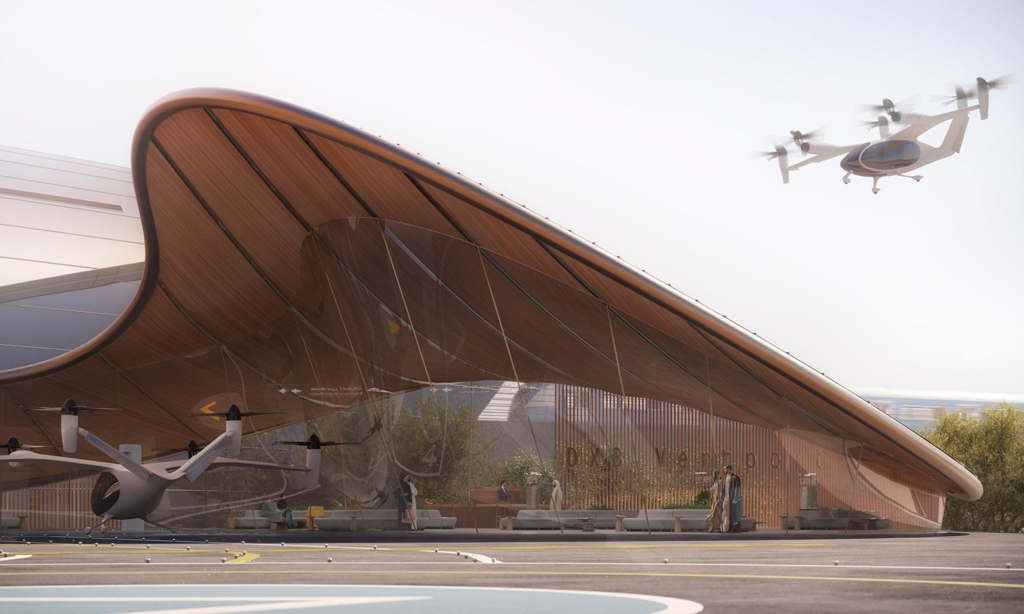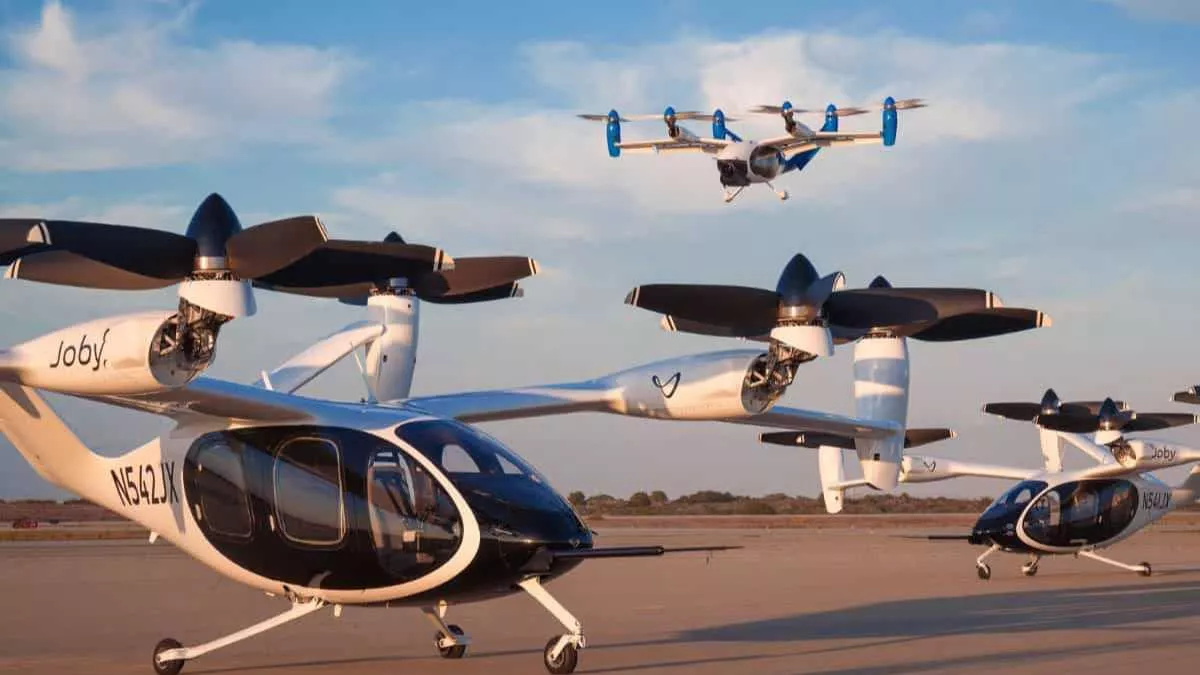Dubai has officially started the construction of its First Aerial Taxi Vertiport at Dubai International Airport (DXB), signaling a bold step toward realizing its ambitious vision of electric air taxis.
This project, developed in collaboration with Dubai’s Roads and Transport Authority (RTA) and Skyports, serve as the foundation for the introduction of electric vertical take-off and landing (eVTOL) aircraft, which are set to transform urban mobility.
Set for completion in the coming years, this development forms part of a larger initiative to launch commercial air taxis in Dubai by 2026. The vertiport will be a crucial element of Dubai’s advanced transportation ecosystem, positioning the city as a global leader in air mobility.
The Ambitious Vision for First Aerial Taxi Vertiport
Dubai has always prided itself on being at the forefront of technological advancements, and its commitment to electric air taxis is no exception. The construction of the first vertiport at Dubai International Airport is a testament to Dubai’s push to be the world’s first city to integrate electric air taxis into everyday life.
This move is part of a high-profile initiative that aims to reduce traffic congestion, provide faster commuting options, and create an efficient and sustainable urban mobility network.
The construction of the first vertiport is just the beginning of a multi-phase project that will ultimately see a network of four vertiports across Dubai. By 2026, these locations—Dubai International Airport (DXB), Palm Jumeirah, Dubai Marina, and Downtown Dubai—will be fully operational, facilitating seamless electric air taxi services across the city.
As one of the world’s most innovative cities, Dubai’s interest in eVTOL technology reflects the emirate’s ongoing commitment to sustainability and futuristic urban solutions. By reducing travel times significantly, Dubai’s air taxis will allow passengers to avoid traffic jams while offering a unique, eco-friendly mode of transport.
Read :Dubai Princess Launches ‘Divorce’ Perfume After Publicly Divorcing Husband
The first vertiport, located at DXB, is a key component of this plan. With its strategic location at the world’s busiest international airport, the DXB vertiport will provide direct access to the heart of Dubai’s global travel hub.
The three-story, 3,100-square-meter facility will serve as the first operational base for the electric air taxis, linking to Dubai’s existing transportation infrastructure, such as the Dubai Metro’s Emirates Station 2 and other transit options.
Construction has begun on the first vertiport in our planned Dubai air taxi network!
— Joby Aviation (@jobyaviation) November 12, 2024
Situated at Dubai International Airport (DXB), the vertiport is designed for exceptional passenger experience and high throughput to deliver convenient and seamless travel between key… pic.twitter.com/ESA6u2ZP1B
This integration will allow for a seamless travel experience for passengers, as they will be able to switch between different modes of transport effortlessly.
The design of the DXB vertiport emphasizes sustainability and efficiency. Equipped with Joby Aviation’s Global Electric Aviation Charging System (GEACS), the facility will ensure quick recharging of air taxis between flights, a necessity for maintaining a frequent-use network. This system will enable a rapid turnaround of eVTOL aircraft, making it a vital component for the success of the service.
Navigating Challenges: Regulatory Hurdles and Tight Timelines
While the vision for Dubai’s electric air taxis is clear, the path to realizing it is fraught with challenges. One of the biggest hurdles is the regulatory landscape, which is still in its infancy in terms of urban air mobility.
Damian Kysely, Head of Infrastructure for Europe and the Middle East at Skyports, has emphasized the ambitious nature of the project’s timeline, with Dubai aiming to be the first city in the world to implement commercial air taxis. This ambitious timeline means that developers and regulatory bodies must work quickly to ensure that everything is in place for the successful launch of air taxi services.
In addition to the tight timeline, navigating the evolving regulatory environment presents significant challenges for Skyports and Joby Aviation. New regulations need to be developed to cover all aspects of urban air mobility, including fire safety, aircraft certification, airspace management, and public safety.
Given that electric air taxis are still a new mode of transport, authorities must ensure that all safety protocols and standards are in place before they can be rolled out to the public. This will require close cooperation between multiple stakeholders, including the RTA, the aviation industry, and local authorities.

Another challenge is integrating the new vertiport infrastructure with existing transportation networks. For example, the DXB vertiport will need to coordinate with the existing airport terminals and air traffic control systems.
Additionally, air taxis will need to navigate through busy airspace while ensuring the safety of passengers and other aircraft. Dubai’s aviation authorities will need to develop clear guidelines and infrastructure to manage this new mode of transport, balancing the demand for innovation with the need for public safety.
Despite these challenges, the collaboration between Joby Aviation, Skyports, and Dubai’s Roads and Transport Authority (RTA) has been instrumental in ensuring the success of the project. The partners are committed to overcoming the regulatory hurdles and technological obstacles that stand in the way of launching commercial air taxis in Dubai.
Joby Aviation’s Role and the Future of Urban Air Mobility in Dubai
At the heart of Dubai’s air taxi initiative is Joby Aviation, a leading player in the eVTOL industry. The company’s partnership with the RTA, signed in February 2024, positions Joby as Dubai’s exclusive air taxi operator through 2030.
This exclusive agreement means that Joby Aviation will be the sole provider of electric air taxis in Dubai, overseeing the operation and development of the city’s air mobility network.
Joby Aviation’s electric air taxis are capable of carrying four passengers and a pilot, providing a fast and environmentally friendly alternative to traditional transportation. These aircraft are designed to take off and land vertically, allowing them to operate from locations like vertiports without the need for runways.
The eVTOL technology offers several advantages, including lower noise levels compared to traditional helicopters, reduced emissions, and the ability to bypass traffic congestion on the ground. For passengers, the benefits are clear: reduced travel times, greater convenience, and a unique way to experience the city.
For example, a journey from DXB to Palm Jumeirah, which can take up to 45 minutes by car due to heavy traffic, is expected to take just 12 minutes by air taxi. The reduced travel time is expected to be a game-changer for both business travelers and tourists, allowing them to make the most of their time in the city.

In addition to the four core vertiports being developed for Phase 1, there are plans to expand the network further in the future. Skyports, the infrastructure provider, is already evaluating existing infrastructure such as heliports for potential use as additional vertiport sites. While there is no confirmed timeline for these additional locations, the expansion of the network will help to further integrate air taxis into Dubai’s transportation landscape.
The launch of commercial air taxis in Dubai also represents a significant leap forward in the development of urban air mobility (UAM) globally. As one of the world’s leading innovation hubs, Dubai’s commitment to air taxis is expected to inspire other cities around the world to explore similar transportation solutions. As urbanization continues to grow, cities will need to explore new ways of moving people efficiently, and air taxis offer a promising solution.
Dubai’s decision to begin construction of its first vertiport at DXB marks the start of an exciting new chapter in the city’s transportation history. By 2026, air taxis could be a common sight in the skies above Dubai, offering residents and visitors a fast, eco-friendly, and convenient mode of transportation.
However, the success of this project hinges on overcoming several challenges, including tight timelines, regulatory hurdles, and the integration of air taxis into Dubai’s existing infrastructure.
With Joby Aviation at the helm, supported by Skyports and the RTA, Dubai is well on its way to becoming a global leader in urban air mobility. The development of the first vertiport is just the beginning, with plans for further expansion already underway.
If successful, Dubai’s air taxi network will not only transform the city’s transportation system but also pave the way for other cities around the world to follow suit. As Dubai continues to innovate and push the boundaries of urban mobility, the future of transportation looks brighter than ever.
let’s enjoy few years on earth with peace and happiness….✍🏼🙏

